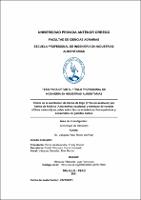Efecto de la sustitución de harina de trigo (Triticum aestivum) por harina de kiwicha (Amaranthus caudatus) y residuos de naranja (Citrus sinensis) en polvo sobre las características fisicoquímicas y sensoriales de galletas dulces

Ver/
Descargar
(application/pdf: 870.6Kb)
(application/pdf: 870.6Kb)
Fecha
2021Autor(es)
Vásquez Vela, Rocío del Pilar
Metadatos
Mostrar el registro completo del ítemResumen
Se evaluó el efecto de la sustitución de harina de trigo (Triticum
aestivum) por harina de kiwicha (Amaranthus caudatus) (10, 15 y
20%) y residuos de naranja en polvo (Citrus sinensis) (3, 6 y 9%) sobre
el contenido de proteína, color, firmeza, fibra cruda y aceptabilidad
general en galletas dulces. El análisis estadístico para todas las
variables se realizó a un nivel de confianza del 95%. La
homogeneidad de varianzas en las variables paramétricas fue
demostrada con la prueba de Levene modificada (p>0.05). El análisis
de varianza indicó un efecto significativo (p<0.05) de la harina de
kiwicha y residuos de naranja en polvo sobre el contenido de
proteínas, color (L*, a* y b*), firmeza y fibra cruda. Se determinó que
el tratamiento de harina de kiwicha al 20% y residuos de naranja en
polvo al 9% presentó el mayor contenido de proteínas y fibra cruda; el
tratamiento 15% de harina de kiwicha y 6% residuos de naranja en
polvo presentó la mejor firmeza y el tratamiento 10% harina de kiwicha
y 3% residuos de naranja en polvo presentó el mejor color. La prueba
de Friedman indicó efecto significativo (p<0.05) de la harina de
kiwicha y residuos de naranja en polvo sobre la aceptabilidad general.
La prueba de Wilcoxon denotó que el tratamiento 15% harina de
kiwicha y 6% residuos de naranja en polvo tuvo la mayor aceptación
con 8 puntos, correspondiente a una percepción de “me agrada
mucho”; pudiendo considerarse como el mejor tratamiento con fines
de una aplicación comercial The effect of substituting wheat flour for kiwicha flour (10, 15 and 20%)
and orange powder residues (3, 6 and 9%) was evaluated on protein
content, color, firmness, crude fiber, and general acceptability in
cookies was evaluated. Statistical analysis for all variables was
performed at a 95% confidence level. The homogeneity of variances
in the parametric variables was demonstrated with the modified
Levene's test (p> 0.05). Analysis of variance indicated a significant
effect (p< 0.05) of kiwicha flour and powdered orange residues on
protein content, colour (L*, a* and b*), firmness and crude fiber. It was
determined that the treatment of 20% kiwicha flour and 9% orange
powder residues presented the highest protein and crude fiber
content; the treatment of 15% kiwicha flour and 6% powdered orange
residues presented the best firmness and the treatment of 10%
kiwicha flour and 3% powdered orange residues presented the best
color. Friedman's test indicated a significant effect (p<0.05) of kiwicha
flour and powdered orange residue on overall acceptability. The
Wilcoxon test indicated that the 15% kiwicha flour and 6% orange
powder residue treatment had the highest acceptance with 8 points,
corresponding to a perception of “I like it a lot”; it can be considered as
the best treatment for the purposes of a commercial application
Palabras clave
Colecciones
- Industrias Alimentarias [153]

